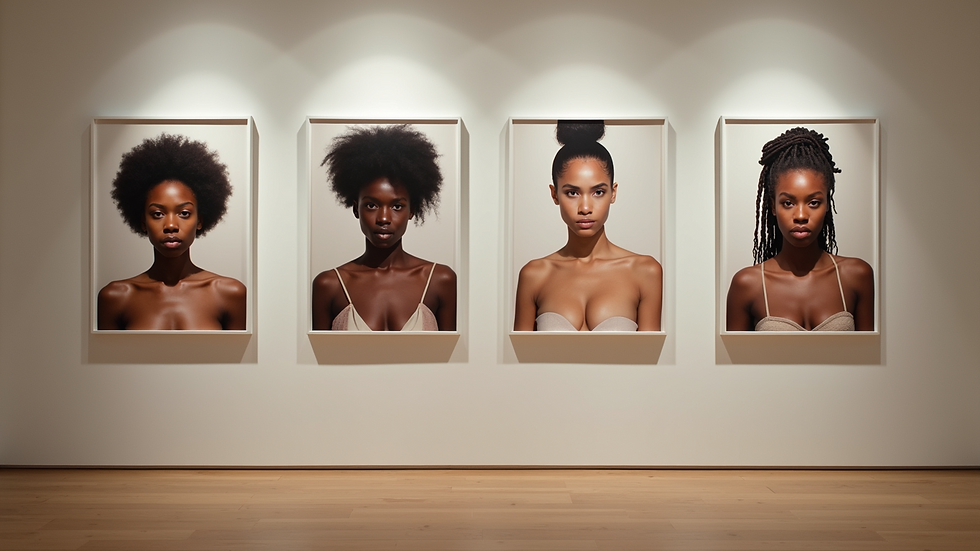Discover Unique Art Inspired by the Human Form
- Lesley Stedmon
- 3 days ago
- 3 min read
Art inspired by the human form has fascinated creators and audiences for centuries. The human body offers endless possibilities for expression, capturing emotions, movement, and stories in ways no other subject can. This post explores how artists interpret the human form in unique and compelling ways, revealing the depth and diversity of this timeless muse.

The Human Form as a Timeless Subject
Artists have long turned to the human body to explore themes of beauty, strength, vulnerability, and identity. Unlike landscapes or objects, the human form is dynamic and complex. It changes with age, emotion, and experience, making it a rich source of inspiration.
Historical significance: From ancient Greek statues to Renaissance paintings, the human form has been central to artistic achievement.
Cultural variations: Different cultures emphasize various aspects of the body, reflecting their values and aesthetics.
Emotional connection: Viewers often relate to art featuring the human form because it reflects their own experiences and feelings.
Exploring Different Mediums and Techniques
Artists use a wide range of materials and methods to capture the human form. Each medium offers unique possibilities for expression.
Sculpture
Sculptors shape materials like marble, bronze, or clay to create three-dimensional representations. The tactile nature of sculpture allows viewers to appreciate the form from multiple angles.
Example: Auguste Rodin’s The Thinker captures tension and contemplation through muscular detail.
Modern sculptors experiment with abstract shapes that suggest the human body without literal representation.
Painting and Drawing
Two-dimensional art offers flexibility in style and interpretation.
Classical artists focus on realistic anatomy and proportion.
Contemporary painters may use distortion, color, or mixed media to express psychological or social themes.
Photography
Photography captures the human form in real moments, often emphasizing light, shadow, and movement.
Black and white portraits highlight texture and emotion.
Experimental photography plays with angles and focus to create abstract body images.
Unique Artistic Interpretations of the Human Form
Artists often push boundaries to present the human body in new ways. These interpretations challenge traditional ideas of beauty and identity.
Abstract and Fragmented Forms
Some artists break the body into shapes or fragments to explore themes like memory, trauma, or transformation.
Example: Pablo Picasso’s Cubist portraits deconstruct faces and bodies into geometric forms.
This approach invites viewers to see the human form beyond surface appearance.
Body as Landscape
Artists sometimes treat the body like a landscape, focusing on curves, lines, and textures.
Close-up views of skin, muscles, or hair become abstract patterns.
This perspective highlights the body’s natural artistry and complexity.
Movement and Fluidity
Capturing motion adds life and energy to representations of the human form.
Dance photography freezes moments of grace and power.
Paintings with flowing lines suggest continuous movement and change.
The Role of Identity and Diversity in Human Form Art
Modern artists increasingly emphasize diversity in body types, ages, genders, and ethnicities. This shift broadens the definition of beauty and challenges stereotypes.
Portraits of older adults celebrate aging and wisdom.
Art featuring diverse body shapes promotes body positivity.
Gender-fluid and non-binary representations question traditional norms.
How to Appreciate and Engage with Art Inspired by the Human Form
Understanding the artist’s intent and the context behind the work enriches the viewing experience.
Look for details that reveal emotion or story.
Consider the cultural background influencing the style.
Reflect on your own response and what the art evokes.
Visiting galleries, museums, or online exhibitions dedicated to figurative art can deepen your appreciation. Try sketching or photographing the human form yourself to connect with the creative process.
Bringing Human Form Art into Your Space
Incorporating art inspired by the human body into your home or workspace adds character and conversation.
Choose pieces that resonate with your personal values or aesthetics.
Mix styles and mediums for a dynamic display.
Use lighting to highlight textures and shapes.
Final Thoughts
Art inspired by the human form offers a powerful way to explore what it means to be human. Its endless variety invites us to see ourselves and others with fresh eyes. Whether through sculpture, painting, or photography, this art connects us to shared experiences and emotions.
Explore local artists or online collections to discover unique works that speak to you. Embrace the beauty and complexity of the human form as a source of inspiration and reflection.




Comments